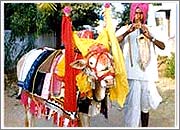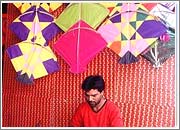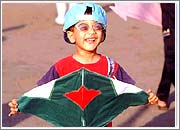Introduction
 Makar Sankranti is celebrated with fervour all over India though in
different names and forms. It is considered as the most auspicious
day by the Hindus.
Makar Sankranti is celebrated with fervour all over India though in
different names and forms. It is considered as the most auspicious
day by the Hindus.
The Makar Sankranti festival marks the day when the sun begins its
northward journey and enters the sign of Makar (the Capricorn) from
the Tropic of Cancer. In other words, the sun moves from
Dakshinayana (south) to Uttarayana (north). The day falls on the
14th of January every year according to the Solar Calendar.
On this day people take a holy dip at Prayag and Ganga Sagar and
worship Sun. The tradition of kite flying adds zeal to the festival.
Origin
Makar Sankranti festival holds special significance according to the
solar calendar as the day and night are of exactly equal duration on
this day. For the people of northern hemisphere, the northward path
of the sun marks the period when the sun is getting closer to them.
This signifies that the days will get longer and warmer after Makar
Sankranti.
The importance of the day was noted even by the Aryans who
celebrated the auspicious day as a festival. Also, an episode from
the great epic Mahabharata shows that people in early times marked
the day as auspicious. Warrior-hero Bhishma Pitamah even after being
wounded in the Mahabharata war lingered on till Uttarayan set in.
Death on this day is set to bring Moksha or salvation for the
deceased.
Celebrations
 The
festival of Makar Sankranti is highly regarded by the Hindus from
North to down South. The day is known by various names and a variety
of traditions are witnessed as one explores the festival in
different states.
The
festival of Makar Sankranti is highly regarded by the Hindus from
North to down South. The day is known by various names and a variety
of traditions are witnessed as one explores the festival in
different states.
In Uttar Pradesh, Sankrant is called 'Khichiri'.
Taking a dip at the confluence of Ganga, Yamuna and the mythical
Saraswati at Sangam, Allahabad is considered auspicious on the day.
In Punjab, the eve of Makar Sankranti is celebrated as 'Lohri' in
which bonfires are lit and people make merry. The following day,
which is Sankrant is celebrated as 'Maghi'. The
Punjabi's dance their famous Bhangra dance till they get exhausted.
In Bundelkhand and Madhya Pradesh the festival is known as 'Sukarat'
or 'Sakarat' and is celebrated with great pomp merriment
accompanied by lot of sweets.
While in Bengal, a big fair is held at Ganga Sagar
where the river Ganga enters the sea.
In Gujarat, there is a custom of giving gifts to relatives. The
Gujarati Pundits on this auspicious day grant scholarships to
students for higher studies in astrology and philosophy.
Kite flying is also associated with this festival in a big
way and has become an internationally well-known event.

In Maharashtra, there is a custom to exchange a sweet preparation
called 'til-polis' as a token of love. Besides,
married women are invited for a get-together called, 'Haldi-Kumkoo'
and given gifts of any utensil, purchased by the woman of the house.
Down South, Sankranti festival is known by the name of 'Pongal'.
The festival gets its name from the surging of rice boiled in a pot
of milk. It is very popular particularly amongst farmers. On this
day, people worship the Sun.
It is also a big event for the Tamils and the people of Andhra
Pradesh. The Telugus call makar sankranti as 'Pedda Panduga',
meaning, 'big festival'. The event is celebrated for four days. The
first day is called 'Bhogi', the second day, 'Sankranti', the third
day, 'Kanuma' and the fourth day, 'Mukkanuma'.
